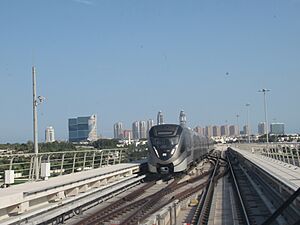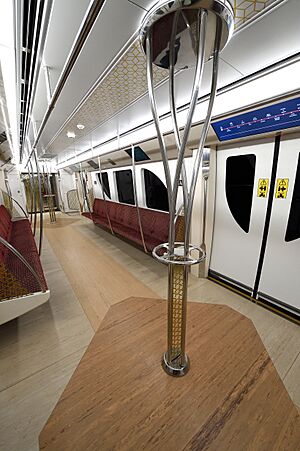Doha Metro facts for kids
Quick facts for kids Doha Metro |
|
|---|---|
 250px 250px |
|
| Info | |
| Owner | |
| Locale | Doha Metropolitan Area |
| Transit type | Rapid transit |
| Number of lines | 3 |
| Number of stations | 37 |
| Headquarters | Doha |
| Operation | |
| Began operation | 8 May 2019 |
| Operator(s) | RKH Qitarat (Hamad/Keolis-RATP Dev) |
| Train length | 3 |
| Headway | 2–5 minutes |
| Technical | |
| System length |
|
| Track gauge | 1,435 mm (4 ft 8 1⁄2 in) standard gauge |
| Electrification | 750 V DC third rail |
| Top speed | 107 km/h (66 mph) |
The Doha Metro is a modern train system in Doha, the capital city of Qatar. It started running on May 8, 2019. This system has three main lines, covering about 76 kilometers, and serves 37 stations. It is a key part of Qatar's bigger railway plan. The Doha Metro uses some of the fastest driverless trains in the world, reaching speeds of up to 100 kilometers per hour.
The Doha Metro is managed by a company called RKH Qitarat. This company is a partnership between Hamad Group and two French transport companies, Keolis and RATP Dev. They operate and maintain the system for 20 years.
Contents
History of the Doha Metro
The idea for a railway network in Qatar began in 2009. A company called Qatari Diar and Deutsche Bahn from Germany worked together on the plan. By 2011, Qatar Rail took full ownership of the project. Deutsche Bahn's experts helped as the main consultants.
Construction of the Doha Metro officially started in 2013. The first major step was a special ceremony at the Msheireb station site. Many international companies helped build different parts of the Red and Green Lines. For example, Salini Impregilo managed the northern part of the Red Line. QDVC and Porr worked on the southern Red Line and the Green Line. In 2014, a group of companies including Larsen & Toubro started building the Gold Line. A total of 21 special machines called tunnel-boring machines were used to dig the underground tunnels.
Metro Lines
The Doha Metro has three main lines that opened in phases between 2019 and 2020. The full system is expected to be completed by 2026. The Red, Green, and Gold Lines all meet at a central station called Msheireb in downtown Doha.
| Line | Opened | Length |
Stations | Ends at | Status | |
|---|---|---|---|---|---|---|
| Red Line M1 | May 8, 2019 (partially) December 10, 2019 (fully) |
40 | 18 | Lusail Hamad International Airport Al Wakra |
operating | |
| Green Line M2 | December 10, 2019 | 22 | 11 | Al Riffa Al Mansoura |
operating | |
| Gold Line | November 21, 2019 | 14 | 11 | Al Aziziya Ras Abu Aboud |
operating | |
| Blue Line | Expected: 2027 | 17.5 | 14 | Hamad International Airport Terminal 2 West Bay QIC |
planned | |
| Total | 93 | 54 | ||||
Building the Metro Lines
Many different companies, both local and international, worked together to build the first phase of the Doha Metro. Qatar Rail made sure that Qatari companies partnered with international firms. This helped local businesses get involved in the project.
- Red Line North (Underground): This part runs from Msheireb to Al Khor. A group of companies including Salini Impregilo built this section.
- Red Line South (Underground): This section goes from Msheireb to Mesaieed. QDVC, GS Engineering & Construction, and Al Darwish Engineering worked on this.
- Green Line: This line connects Msheireb to Al Riffa. It includes underground, elevated, and ground-level sections. PORR Bau and other partners built this line.
- Gold Line: This line connects nine underground stations. A group of companies, including Ellaktor and Larsen and Toubro, won the contract to build it.
Metro Stations
When the Doha Metro project is fully finished, it will have about 100 stations. Msheireb station is the main hub where the Red, Green, and Gold Lines meet. Qatar Rail decided to name the stations after historic towns and cities in Qatar. Each name has its own special story.
Phase 1 Stations
- Red Line (Coastal Line)
This line connects towns like Lusail, West Bay, Msheireb, Hamad International Airport, and Al Wakra.
- Lusail QNB
- Qatar University
- Leqtaifiya
- Katara Cultural Village
- Al Qassar
- DECC
- West Bay Qatar Energy
- Corniche
- Al Bidda
- Msheireb
- Al Doha Al Jadeda
- Umm Ghuwailina
- Al Matar Al Qadeem
- Oqba Ibn Nafie
- Hamad International Airport Terminal 1
- Free Zone
- Ras Bu Fontas
- Al Wakra
- Green Line (Education Line)
The Green Line runs along Al Rayyan Road. It connects Education City with the center of Doha. It also links to Umm Salal and the Industrial Area South.
- Al Riffa Mall of Qatar
- Education City
- Qatar National Library
- Al Shaqab
- Al Rayyan Al Qadeem
- Al Messila
- Hamad Hospital
- The White Palace
- Al Bidda
- Msheireb
- Al Mansoura
- Gold Line (Historic Line)
The Gold Line travels from east to west. It connects Airport City North through central Msheireb with Al Waab Street, Al Rayyan South, and Salwa Road.
- Ras Bu Abboud
- National Museum of Qatar
- Souq Waqif
- Msheireb
- Bin Mahmoud
- Al Sadd
- Joaan
- Sudan
- Al Waab QLM
- Sports City
- Al Aziziya
Most stations offer free bus services to nearby places. A standard ticket costs 2 Qatari Riyals for one trip. A 'gold club' ticket costs 10 Qatari Riyals.
Phase 2 Plans
The next phase of the Doha Metro will include the Blue Line. This entire project is expected to be finished by 2026. More details about the stations for this phase will be shared by Qatar Rail later.
Metro Design
The design for the Doha Metro stations was chosen in October 2013. It is called "Vaulted Spaces." This design takes ideas from old Islamic architecture and uses them in a modern way. The company that designed the stations, UNStudio, wanted to show a link between Qatar's past and its future.
One special part of the design is the outside shape of the stations. It uses bright, new materials to look like the inside of an oyster shell. Inside the stations, the different levels are open to each other. This makes passengers feel comfortable. The lights and air systems are hidden within the curved shapes of the arches.
The trains themselves were designed to show Qatar's culture. The Emir of Qatar personally chose the outside look of the trains. It was inspired by the shape of an Arabian horse.
Technology Used
Trains and Equipment
The Doha Metro uses 75 driverless trains, each with three cars. These trains were supplied by Japanese companies, Mitsubishi Corporation and Kinki Sharyo. The first trains arrived in Qatar in August 2017.
A French company called Thales Group provides the systems that control the trains. They also supply the communication, security, and ticket collection systems. Mitsubishi Heavy Industries supplies the tracks and power for the trains. They also provide the doors at the edge of the platforms and the ventilation systems for the tunnels.
Underground Tunnels
The Metro network covers the greater Doha area. It connects to city centers and important business and living areas. In central Doha, the Metro runs underground. Outside the city, it runs mostly at ground level or on elevated tracks.
For the underground parts, Qatar Rail used special machines called tunnel boring machines (TBMs). A total of 21 TBMs were used to dig tunnels 20 meters below the city. Each TBM was very large, about 7.05 meters wide and 120 meters long. They had to be taken apart to be moved.
Each TBM dug between 7 to 9 kilometers of tunnel. It took about two years for each machine to finish its tunnel. The TBMs dug at a speed of 12 to 21 meters per day.
Qatar Rail has been recognized by Guinness World Records for having "The Largest Number of Tunnel Boring Machines Operating Simultaneously in a Single Project." This means they had 21 TBMs working at the same time, which broke the old record of 19. In 2017, the Doha Metro project also won an award from the International Tunneling and Underground Space Association.
Safety and Security
Safety is very important for the Doha Metro. During the digging of the underground tunnels, many safety rules were followed. These rules made sure that workers were safe and that emergencies could be handled quickly.
Qatar Rail has a special safety and security program for the railway network. This program plans for emergencies and how to respond to them. It also looks at laws and how different groups work together to keep the system safe. In September 2014, Qatar Rail held a workshop with experts from the UK and Qatar to discuss safety and security plans.
In June 2014, the Doha Metro Green Line project reached a big safety milestone. Workers completed 6 million hours without any serious injuries.
How the Metro Operates
The Doha Metro runs using a system called Grade of Operation level 4 (GoA4). This means the trains are fully automated. They start, stop, open doors, and handle emergencies all by themselves, without any staff on board.
The network has two types of travel classes: standard and goldclub. Standard tickets cost 2 Qatari Riyals per trip. Goldclub tickets cost 10 Qatari Riyals. There are also three types of train cars: standard, goldclub, and family cars. Family cars are for families and single women, but not for men traveling alone. During the 2022 FIFA World Cup, all cars were used as standard cars to carry more passengers.
Images for kids
-
A view of the completed Al Wakrah metro station, part of the Red Line, in June 2019
See also
 In Spanish: Metro de Doha para niños
In Spanish: Metro de Doha para niños






